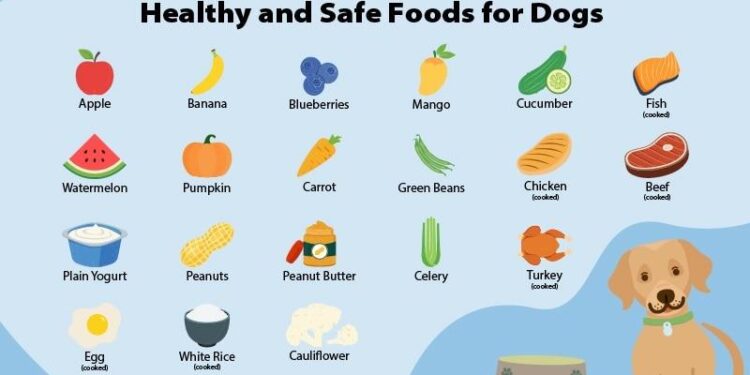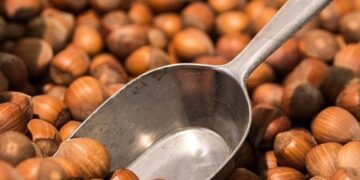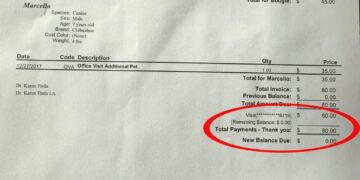Table of Contents
The 2 A.M. Panic: A Story We All Know
The journey often begins in the disorienting quiet of the early morning, shattered by a sound every dog owner recognizes with a jolt of adrenaline: the unmistakable retching of a dog in distress.
For the archetypal owner, sleep is instantly forgotten.
There is the frantic rush to the door, the cleanup under the harsh glare of a kitchen light, and the profound worry that settles in as their companion stands hunched and miserable, refusing even a comforting P.T.1
The dog’s lethargy and visible discomfort—perhaps a tender abdomen or the alarming “praying position” with front legs down and rear end up—signal a problem that feels both urgent and mystifying.1
In this moment of helplessness, the modern owner’s first instinct is to turn to the digital world.
A frantic search for “dog upset stomach” unleashes a torrent of conflicting advice from forums, blogs, and social media groups.
The sheer volume of information is overwhelming, amplifying the owner’s anxiety.
Yet, amidst the noise, a single recommendation emerges with the force of a cultural consensus: “Give him boiled chicken and rice.” It is presented as the time-honored, veterinarian-approved first line of defense.
For the worried owner, this advice is a lifeline.
It is simple, actionable, and feels like a concrete step toward a solution.
The act of preparing this meal becomes a powerful coping mechanism; it is as much about soothing the owner’s own anxiety by “doing something” as it is about treating the dog.
In a moment of chaos, this simple recipe offers a semblance of control, a belief in a trusted remedy that will surely set things right.
This is where the conventional path begins—a path that, for many, leads not to recovery, but to a deeper and more complex problem.
The “Chicken and Rice” Fallacy: Why the Old Standby Is a Broken Tool
The recommendation for a bland diet of boiled chicken and white rice is rooted in a logical, albeit outdated, principle: to rest an inflamed gastrointestinal (GI) tract.
The diet is low in fat and fiber, which makes it highly digestible and minimizes the work required of the stomach and intestines.
The goal was to provide basic energy without further irritating an already compromised system.
For decades, this was the standard of care, a seemingly sensible approach to a common ailment.
However, modern veterinary nutrition science has revealed this old standby to be a fundamentally broken tool, one that can inadvertently hinder recovery.
The first and most glaring issue is its profound nutritional inadequacy.
A diet consisting solely of boiled chicken breast and white rice is deficient in 17 essential nutrients required by an adult dog.
It lacks critical vitamins like A, D, E, and B12, and is dangerously low in minerals and electrolytes such as calcium, potassium, phosphorus, and sodium.
These are the very nutrients a dog is actively losing through vomiting and diarrhea, meaning this diet fails to replenish what is most needed for healing.
Feeding a nutritionally incomplete meal to an already sick and compromised patient can prolong their illness rather than accelerate their recovery.
Beyond the nutrient void, the diet presents an energy crisis.
To meet the daily caloric needs of a 60-pound dog, an owner would need to prepare approximately 405 grams of chicken breast and 515 grams of white rice—nearly a kilogram of food per day.
For a sick dog with a diminished appetite, consuming such a large volume is often impossible, pushing them into a negative energy balance that further weakens their ability to heal.
The diet can also actively worsen the situation.
Chicken is one of the most common food allergens for dogs.
If the underlying cause of the GI upset is an undiagnosed chicken sensitivity, feeding this diet will pour fuel on the fire, exacerbating inflammation and diarrhea.
Furthermore, the low and non-ideal fiber content of white rice does little to regulate stool consistency and can sometimes make diarrhea worse.
Finally, many owners report a frustrating long-term consequence: after a few days of the highly palatable chicken and rice, their dog refuses to return to their balanced commercial food, creating a picky eater and risking chronic nutritional deficiencies down the line.
For the owner in our narrative, this is the critical turning point.
The dog either fails to improve, improves only to relapse, or gets demonstrably worse.
This failure of the conventional “cure” is not a dead end; it is a crucial diagnostic clue.
It signals that the problem is more complex than a simple upset stomach and that a deeper understanding is required—an understanding that begins with the intricate world living inside the gut.
Table 1: Nutritional Showdown: Chicken & Rice vs. A Modern Veterinary GI Diet
| Nutrient | Typical Homemade Chicken & Rice | Sample Veterinary GI Diet (e.g., Hill’s i/d) |
| Nutritional Profile | Incomplete & Unbalanced | Complete & Balanced for Recovery |
| Protein | Variable, often low | Guaranteed Minimum 23.0% |
| Fat | Low | Controlled for digestibility (Min 10.5%) |
| Calcium | Deficient | Guaranteed Minimum 1.1% |
| Potassium | Deficient | Guaranteed Minimum 0.85% |
| Vitamin B12 | Negligible | Supplemented |
| Prebiotic Fiber | Negligible (from white rice) | Included (e.g., ActivBiome+ Tech) |
| Electrolytes | Deficient | Supplemented to replace losses |
The Gut as a Garden: A Paradigm Shift in Canine Wellness
The failure of the old approach forces a new perspective, one that views an upset stomach not as a localized plumbing issue, but as a symptom of a systemic imbalance within a complex, living ecosystem: the gut microbiome.
The most effective way to understand this system is through an analogy: the gut as a garden.
This internal garden is home to trillions of microorganisms—bacteria, fungi, and other microbes—that are essential for health.
- The Plants & Flowers (Beneficial Bacteria): These are the “good” microbes that perform vital functions. Species like Faecalibacterium and Lactobacillus help digest food, produce essential vitamins like B and K, and manufacture over 90% of the body’s serotonin, a key neurotransmitter affecting mood and anxiety. Crucially, they also train and regulate the immune system, which is about 70% housed in the gut.
- The Soil (The Gut Lining): This is the intestinal barrier. In a healthy garden, the soil is rich and intact, allowing nutrients to be absorbed while preventing toxins, pathogens, and undigested food particles from leaking into the bloodstream—a condition known as “leaky gut”.2
- The Weeds (Pathogenic Bacteria): These are the “bad” microbes, like certain species of Clostridium, which are always present in small numbers but can cause disease if they overgrow and choke out the beneficial flora.
- Fertilizer & Sunlight (Diet & Prebiotics): Food is the fuel for this entire ecosystem. Prebiotics—specific types of dietary fiber found in foods like pumpkin and chicory root—are the specialized fertilizer that selectively nourishes the beneficial bacteria, helping them thrive and keep the weeds in check.
An upset stomach, particularly diarrhea or vomiting, is a sign of dysbiosis: a state where the garden is overrun.
This imbalance can be triggered by antibiotics (which act like an indiscriminate herbicide, killing good and bad bacteria alike), stress, or, most commonly, a diet high in processed carbohydrates and low in the diverse fibers needed to feed the beneficial microbes.
This “gut-garden” concept reveals that digestive health is inextricably linked to overall wellness through the gut-brain-immune axis.
A garden in disarray doesn’t just result in poor digestion; it can manifest as skin allergies, a weakened immune system, chronic inflammation, anxiety, and even aggression.
Therefore, the goal of treatment must shift from simply suppressing symptoms to actively rebalancing and restoring the entire ecosystem.
It’s not about calming an organ; it’s about tending the garden.
The Gut-Healing Toolkit: A Modern Approach to Digestive Recovery
Armed with a new understanding of the gut as a garden, the owner can now deploy a modern toolkit designed to soothe, rehydrate, and restore the ecosystem.
This systematic approach replaces the single, flawed tool of chicken and rice with a multi-faceted strategy for true healing.
Table 2: The Gut-Healing Toolkit at a Glance
| Tool | Primary Function | Recommended Dosage/Use |
| Bone Broth | Hydrate & Soothe | Offer as a primary hydrating liquid; use to moisten other foods. |
| Pumpkin Purée | Regulate & Fertilize | 1 teaspoon per 10 lbs of body weight, per meal. |
| Kefir (Plain) | Reseed | Start with 1/4 – 1/2 teaspoon per day and increase slowly. |
| Probiotic Supplement | Reseed | Follow package directions for canine-specific products. |
Part I: Soothe and Hydrate (Prepare the Soil)
The first step is to calm the inflammation and replenish lost fluids.
- Bone Broth: This is far superior to plain water. It provides essential hydration along with electrolytes like potassium that are lost during GI upset. More importantly, it is rich in collagen and gelatin, which help to coat and soothe the gut lining, providing the building blocks to repair the “soil” and combat leaky gut. A simple homemade broth can be made by simmering bones (beef, chicken, or turkey) in water with a splash of apple cider vinegar for 20-24 hours. It is critical to use no onions or garlic and to strain all bones from the final liquid before serving.
- Plain Pumpkin Purée: This is a digestive powerhouse. Its high content of soluble fiber acts like a sponge, absorbing excess water in the GI tract to help firm up loose stools.3 Simultaneously, this fiber serves as a potent prebiotic—the “fertilizer” that feeds the beneficial bacteria already present in the gut, helping them to repopulate. It is essential to use 100% pure canned pumpkin, not sugary pie filling. A general guideline is one to four tablespoons per meal, depending on the dog’s size.
Part II: Weed and Reseed (Restore the Garden)
Once the inflammation is calmed, the focus shifts to reintroducing beneficial microbes.
- Probiotics & Prebiotics: These two work in synergy. Probiotics are the “seeds”—live, beneficial bacteria that are added to the garden. Prebiotics are the “fertilizer” that feeds them.
- Kefir: A fermented milk drink, kefir is a potent, whole-food source of a wide diversity of probiotic strains, often containing up to 61 different types of bacteria and yeast—far more than yogurt. The fermentation process breaks down most of the lactose, making it well-tolerated by most dogs.4 Introducing it slowly is key to allow the gut to adjust.
- Supplements: High-quality, canine-specific probiotic supplements are another excellent choice. Products containing well-researched strains like Lactobacillus acidophilus, Bifidobacterium animalis, and Enterococcus faecium can effectively help rebalance the microbiome. Veterinarian-recommended brands include Purina FortiFlora and Nutramax Proviable.
Part III: The Recovery Blueprint (A 72-Hour Plan)
This phased approach provides a structured path to recovery.
- Phase 1 (0-12/24 Hours): The Gut Rest. For adult dogs, a short fast of 12-24 hours (less for puppies) allows the inflamed GI tract to rest and reset. During this time, constant access to fresh water, ice chips, or small amounts of bone broth is crucial for hydration.
- Phase 2 (24-48 Hours): Gentle Reintroduction. The fast should be broken with very small, frequent meals of a soupy porridge made from pumpkin purée mixed with bone broth. This is exceptionally gentle, hydrating, and provides immediate prebiotic support.
- Phase 3 (48-72 Hours): Rebuilding. If the initial meals are well-tolerated, a lean, easily digestible protein source like boiled turkey or whitefish can be added (avoiding chicken if a sensitivity is suspected). A small amount of kefir or a probiotic supplement can also be introduced at this stage.
- Phase 4 (Post-72 Hours): The Slow Transition. Once stools are consistently firm, a slow transition back to the dog’s regular food should begin. This process should take 7-10 days, gradually mixing the recovery foods with the normal diet in increasing proportions to allow the microbiome to adapt without shock.
The Professional Partnership: Leveraging Veterinary Science for a Faster Recovery
While the home-care toolkit is highly effective, preparing meals during a stressful illness can be challenging, and long-term homemade diets risk being nutritionally incomplete.
This is where therapeutic veterinary diets, available exclusively through a veterinarian, serve as a powerful, scientifically optimized alternative.
The development and marketing of these diets validate the very microbiome-centric paradigm the owner has just discovered; they are not a separate path, but the commercial application of the “gut garden” principle.
These diets are formulated to be nutritionally complete and balanced for recovery, removing the guesswork for the owner.
- Hill’s Prescription Diet i/d: This formula is built on a foundation of high digestibility and features Hill’s proprietary “ActivBiome+” technology. This is a specific blend of prebiotic fibers clinically shown to rapidly activate the gut microbiome, support optimal stool quality, and promote the growth of beneficial bacteria.5
- Royal Canin Gastrointestinal: This diet focuses on highly digestible proteins to reduce digestive workload, a precise blend of fibers including prebiotics to support a balanced microbiome, and is enriched with omega-3 fatty acids like EPA and DHA to help manage inflammation.6
- Purina Pro Plan EN Gastroenteric: This formula is also highly digestible and contains a select prebiotic fiber for targeted microbiome support, often with a low-fat profile to be gentle on the pancreas and digestive system.
These prescription diets represent a fusion of convenience and cutting-edge science.
They provide all the necessary nutrients, electrolytes, and microbiome-supporting compounds in one bag or can, ensuring a compromised dog receives everything needed to heal efficiently.
The Path to Resilience: From Crisis Management to Proactive Gut Health
The journey through a severe GI upset culminates in a powerful transformation.
The owner, once operating from a place of panicked reaction, is now empowered with a deep understanding of their dog’s internal ecosystem.
The focus shifts from crisis management to building long-term digestive resilience.
The foundation of this resilience is diet.
The single most influential factor in maintaining a healthy gut garden is a consistent, high-quality daily diet.
Research indicates that diets higher in protein and lower in carbohydrates, with a variety of whole-food ingredients, promote a more diverse and robust microbiome.
Elements from the recovery toolkit can be integrated into a long-term wellness plan.
A daily spoonful of pumpkin purée or kefir can provide ongoing fiber and probiotic support.
Lifestyle factors also play a critical role.
Since stress is a known trigger for digestive issues like colitis, regular exercise and mental enrichment are not just for fun—they are essential tools for maintaining the gut-brain balance.
Finally, the lesson of slow dietary transitions—always taking 7-14 days to introduce a new food—becomes a non-negotiable rule to protect the delicate microbial community from sudden shocks.
The owner who completes this journey no longer fears the occasional upset stomach.
They are equipped with knowledge, a practical toolkit, and a strong partnership with their veterinarian.
They have moved from a state of reactive panic to one of proactive, confident care, capable of nurturing their dog’s internal garden for a lifetime of health.
The Red Flag Guide: When to Call Your Veterinarian Immediately
The strategies outlined above are highly effective for managing mild, transient digestive upset.
However, they are not a substitute for professional veterinary diagnosis and care.
Certain symptoms are red flags for more serious conditions and require immediate medical attention.
Table 3: The Red Flag Symptom Checker
| Symptom | Check Box |
| Is there any blood in the stool or vomit (bright red or dark/tarry)? | ☐ Yes |
| Has vomiting occurred more than three times in 24 hours? | ☐ Yes |
| Is the diarrhea profuse, watery, or has it lasted more than 48 hours? | ☐ Yes |
| Is the dog showing signs of severe pain (praying position, yelping)? | ☐ Yes |
| Is the dog extremely lethargic, weak, or has it collapsed? | ☐ Yes |
| Has the dog refused all food and water for more than 24 hours? | ☐ Yes |
| Is the patient a very young puppy, a senior, or a dog with a chronic illness? | ☐ Yes |
If the answer is “Yes” to ANY of these questions, stop home care and contact a veterinarian or emergency clinic immediately.7
Works cited
- Gastroenteritis (stomach upset) in dogs – PDSA, accessed August 16, 2025, https://www.pdsa.org.uk/pet-help-and-advice/pet-health-hub/conditions/gastroenteritis-stomach-upset-in-dogs
- Bone Broth for Dogs: A Superfood With Many Benefits, accessed August 16, 2025, https://www.akc.org/expert-advice/health/bone-broth-for-dogs/
- Pumpkin For Dogs: Tips For Treating an Upset Stomach, accessed August 16, 2025, https://www.thefarmersdog.com/digest/pumpkin-for-dogs/
- Can My Dog Eat Kefir? | The Dog People by Rover.com, accessed August 16, 2025, https://www.rover.com/blog/can-dogs-eat-kefir/
- Hill’s Prescription Diet i/d Digestive Care Chicken Flavor Dry Dog …, accessed August 16, 2025, https://www.petco.com/shop/en/petcostore/product/hills-prescription-diet-id-digestive-care-chicken-flavor-dry-dog-food
- Canine Gastrointestinal Low Fat | Royal Canin US, accessed August 16, 2025, https://www.royalcanin.com/us/dogs/products/vet-products/gastrointestinal-low-fat-dry-dog-food
- Upset Stomach in Dogs: Signs and What To Do | PetMD, accessed August 16, 2025, https://www.petmd.com/dog/conditions/digestive/upset-stomach-dogs






